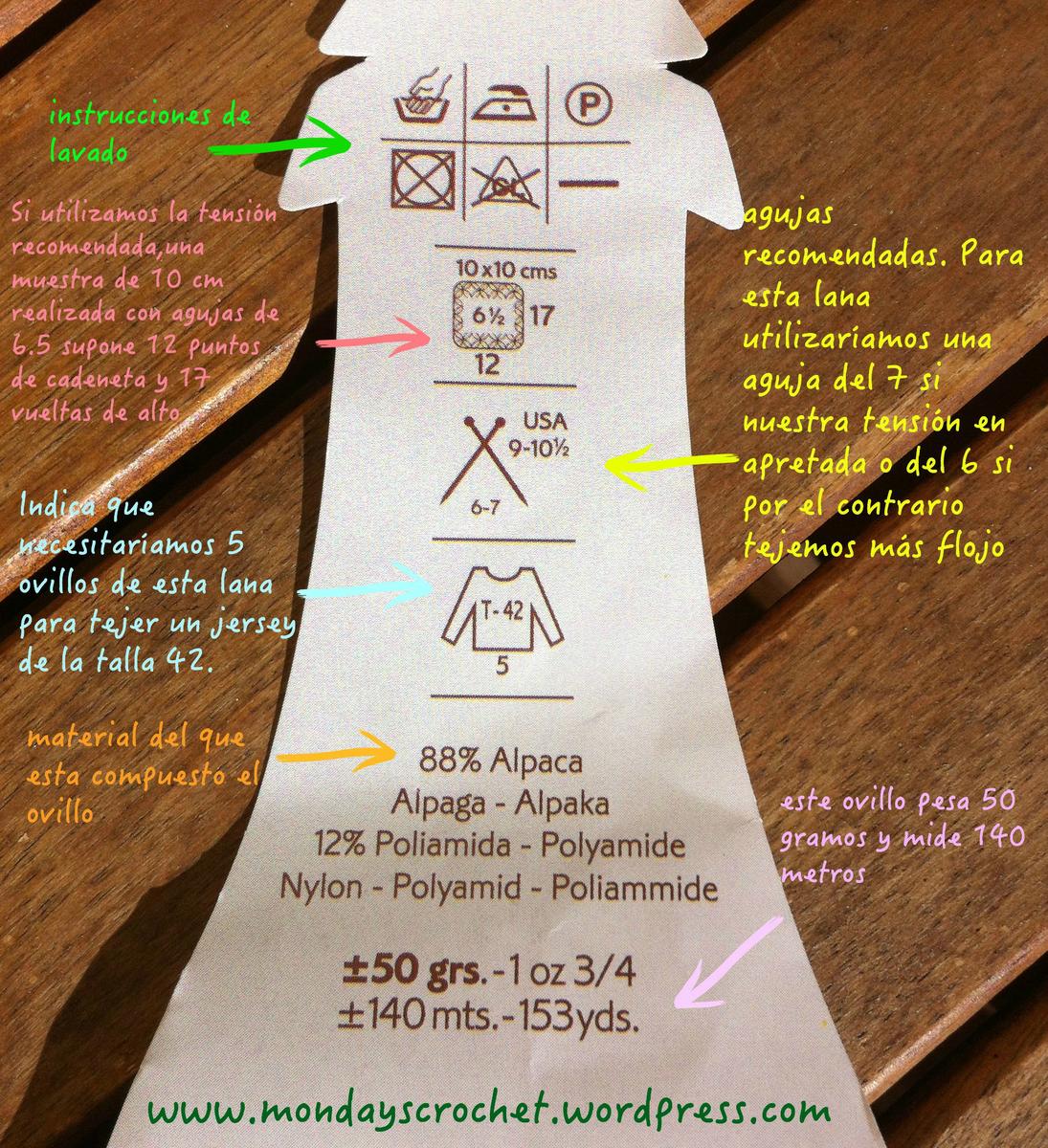Reading the labels can be a bit confusing. We will explain each of the symbols and graphics that appear on the balls.
INSTRUCCIONES DE LAVADO / WASHING INSTRUTIONS
MEDICIÓN DE LA MUESTRA / GAUGE
Antes de comenzar a tejer una prenda recomendamos hacer una muestra. Con este símbolo el fabricante nos proporciona la información de que con una aguja de 6 1/2, haciendo 12 cadenetas de base y 17 vueltas de punto alto, nuestra muestra medirá 10 cm. En esta sencilla prueba podemos comprobar si necesitamos una aguja mayor o menor a la recomendada por el fabricante.
The gauge on your label can be really useful if you?re going to draft your own pattern or substitute a yarn. Check out the little gauge square on the label shown below. It tells us that using size 6 1/2 hook should give us 12 stitches and 17 rows in a 10 x 10 inch square.
NÚMERO DE AGUJA RECOMENDADO POR EL FABRICANTE / HOOK NUMBER RECOMMENDED BY THE MANUFACTURER
El número de aguja recomendado por el fabricante en el ovillo es orientativo. Este número depende del la lana o hilo, pero también de la tensión que ejerce cada persona sobre su labor. Nosotras recomendamos a los principiantes utilizar un número más alto del recomendado por el fabricante. Es decir, si en la etiqueta marca un 6-7, aconsejamos tejer con una aguja de 7 mm. La numeración es diferente en USA, en esta etiqueta para nosotros sería 6-7.
The number of needles recommended by the manufacturer in the ball is only for information. This number depends on the type of yarn, but also on the individual tension of each person. We recommend beginners use a higher number recommended by the manufacturer. I.e., if the label marks a 6-7, we advise knitting with a needle of 7 mm. The numbering is different in the USA, this label for us would be 6-7.
COMPOSICIÓN DE LA LANA O HILO / COMPOSITION
Los ovillos y madejas son de diferentes procedencias. Pueden ser fibras naturales, artificiales o mezclas de estas dos.
Yarn balls are made by different processes. They can be natural, man-made fibres or a mixture of the two.
FIBRAS NATURALES:
Las fibras naturales pueden ser de procedencia animal y vegetal.
De procedencia vegetal: Algodón y lino.
De procedencia animal: Lana (oveja), Cachemir (pelo de cabra), Alpaca (de la familia de los camellos), Llama, Mohair (cabras de Turquía) Angora (pelo de conejo).
NATURAL FIBRE:
Natural Fibres can be of animal or vegetable.
Vegetable origin: Cotton and linen
Animal origin: Wool (sheep), Cashmere (goat), Alpaca (camel family), Lama, Mohair (turkey goat) Angora (rabbit).
FIBRAS SINTÉTICAS:
Proceden de reacciones químicas sucesivas. Las principales son las poliamidas (nylon, perlón), las poliéster (tergal, terital), acrílicas (rhovil). Tienen una gran resistencia al uso. Muchas veces nos encontramos que los ovillos son mezcla de dos fibras naturales o de fibra natural mezclada con sintética.
SYNTHETIC FIBRE:
They are made from successive chemical reactions. The main ones are polyamides (nylon, perlon), polyester (terylene, terital), acrylic (rhovil). They are very resistant to wear. Many times we find that the balls are mixtures of two natural fibres or natural fibre mixed with synthetic.
PESO Y LONGITUD TOTAL DEL OVILLO / WEIGHT AND TOTAL LENGTH OF THE BALL
Los ovillos de lana suelen pesar 50 o 100 grs. Tenemos que tener en cuenta este detalle para calcular los ovillos que vamos a necesitar y cuanto va a costar.
En cuanto a la longitud, nos da una idea de cuanto nos va cundir nuestro ovillo.
The balls of wool often weigh 50 or 100 grs. we have to take into account this detail to calculate the number of balls required and the cost.
The length gives an idea of how much we can make from a single ball of yarn.
COLOR Y TINTADA / COLOR AND DYE
Es muy importante que en todos los ovillos que vayamos a utilizar para tejer una misma prenda estas dos numeraciones coincidan.
It is very important to use the same type of yarn and that the numbers agree.








